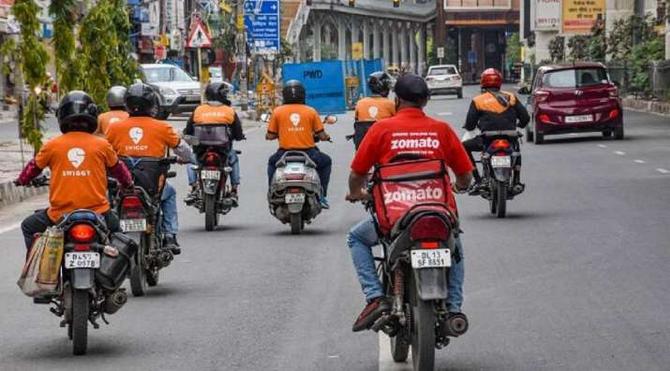Tired of rising commissions, Nitin Chadha, co-owner of Madison & Pike, decided to sever ties with Zomato and Swiggy.

When the Gurugram-based café had tied up with these food aggregators some five years ago, the commission was around 12 per cent.
“It went up to 20-odd per cent in 2019 and to 25 per cent a year later.
"That’s when we decided to pull the plug; it was not sustainable for our business,” says Chadha.
Madison & Pike, instead, turned to Mumbai-based start-up Thrive, which provides third-party delivery services to restaurants at a much lower commission – three to five per cent.
As does Gurugram-headquartered DotPe, another alternative listing platform to which restaurants unhappy with Swiggy and Zomato’s high commission are turning.
What’s also working in the favour of Thrive and DotPe is that they share their customer data and logistical cost of delivery with the restaurants.
And, they give the restaurants the flexibility of choosing how they want to deliver: on their own or through a third party.
Since it was launched in 2020, Thrive says it has amassed over 12,000 restaurant partners and now operates in more than 95 cities.
But it still lagged significantly behind Zomato’s claimed 208,000 restaurant partners in Q1FY23.
On LinkedIn, DotPe, meanwhile, says within a year of its launch in 2020, it was catering to 30,000-plus restaurants and food courts. (Digital ordering, payment and delivery of food is one of DotPe’s verticals.)
“Swiggy and Zomato also charge a higher fee if a restaurant is running an ad or a banner for its promotion.
"So at times, it goes as high as 35-40 per cent,” says Dhruv Dewan, co-founder of Hashtag Loyalty, which operates Thrive.
The fledgling aggregator is backed by Jubilant FoodWorks, which operates the India franchise of Domino’s Pizza.
Known for building its own expansive delivery system, Jubilant had in a letter to the Competition Commission of India (CCI) in July said it plans to move some of its business away from platforms such as Swiggy and Zomato if they increase commission.
In July, the company also launched a reward programme, Domino’s Cheesy Rewards, to drive more traffic to its own website.
Under this, customers would get a free pizza after every six eligible orders.
And to claim that one free pizza, they would have to go through Domino's-run channels instead of ordering from, say, Swiggy or Zomato or even from Domino's outlets.
The “twin benefits of the programme are: drive frequency and attract new customers,” Jubilant FoodWorks Executive vice president and chief financial officer Ashish Goenka said in its Q1 FY23 earnings call.
Zomato and Swiggy did not respond to a request from Business Standard for a statement on competition from new platforms such as Thrive and DotPe or the CCI probe.
Meanwhile, because of the high commission, restaurants are ending up charging higher rates for deliveries than for dine-in menus.
A recent report by Jefferies, which compared pricing of 240 orders across 80 restaurants in eight cities, revealed that 80 per cent of these restaurants charged higher on aggregator platforms than dine-in.
This premium on delivery ranged from 10 per cent to nearly 60 per cent in some cases.
“Differential pricing is being increasingly adopted by restaurants as a measure to offset the take rate charged by the aggregators, which works well for both (platforms & restaurants),” said the Jeffries report.
“While platforms cannot influence the premium charged by a restaurant, a significant mark-up may result in customer dissatisfaction and even open up an opportunity for a hyper-local delivery platform to enable own-deliveries by restaurants,” it added.
From the sample size that Jeffries studied, it found that though discounts bring down the premium, nonetheless customers pay around 15 per cent premium for convenience of delivery.
The analysis found that over 20 per cent of the orders proved to be more expensive on aggregator platforms versus dine-in.
According to research firm Redseer, the Indian online food ordering market is expected to increase from $200 million in 2016 to $12.8 billion in 2025.
With dissonance between restaurants and big aggregators on the rise, this expanding market is up for grabs for new players such as Thrive and DotPe.
The way forward for Madison & Pike might lie in brand-building.
“We are looking at how to increase the visibility of our brand across sites,” says Chadha, adding, “We cannot replicate what Zomato and Swiggy have achieved in terms of listings.
"I think it is up to Thrive on how it is going to make its partners, including us, more accessible to the customer.”
Fight for fair commission
“The commissions (that aggregators charge) are something that everyone has been battling about for a long time,” says Kabir Suri, president, National Restaurant Association of India (NRAI).
“In our and Zomato and Swiggy’s understanding, these commissions are fundamentally dependent on the average order value (AOV) of brands and their transactions,” he explains.
“The way they present data is that higher the AOV, lower the commission.
"We feel there needs to be further rationalisation of their expectations of what is the average cost per transaction,” he adds.
Each transaction consists of a delivery rider, petrol and bike, and the distance the bike covers.
“Basis that, in our understanding, a delivery within a 5-km radius should not cost more than Rs 70.
"However, these platforms justify the percentages, ranging from 10 per cent to 30 per cent, with things like additional costs such as the capital they deploy into setting up the system etc,” Suri says.
For example, a 15-20 per cent commission on an order value of Rs 5,000 is automatically a high cost to deliver.
The question is: how many transactions are of a higher value.
“Their volume transactions are probably sub-Rs 300, so they should not be charging people more than 12-15 per cent at a lower AOV,” Suri says, adding, “We are constantly engaging with them on several issues like commissions, data masking and unbundling to reach a workable solution for both parties.”
NRAI plans to launch its own loyalty programme. The app, says Suri, will be launched closer to Q4.












 © 2025
© 2025